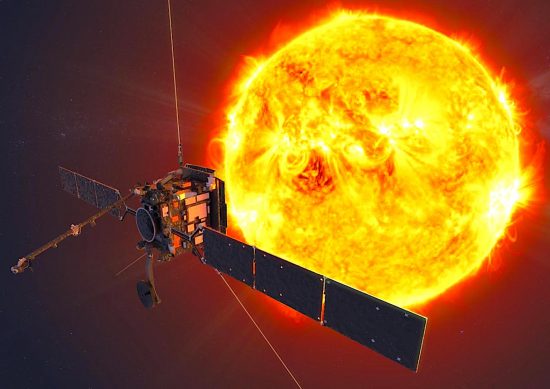
February 12, 2020
A satellite to orbit the Sun.
The Solar System is constantly bombarded by dust particles, but because the Sun’s magnetic field is so strong, most of it is deflected around a bubble-shaped zone that extends beyond Pluto’s orbit. The amount of dust blowing in to the Solar System had increased substantially over the last few years, more than triple what it once was early in 1997.
However, the Sun goes through a cycle of electromagnetic fluctuation that lasts 22 years, so the force field is most likely reduced during times of low solar activity, allowing more charged particles to pass through. In fact, there are times when the Sun seems to funnel ionized interstellar dust along a localized region of increased electric current flow at the poles.
In 1994 the Ulysses spacecraft found that the temperature of the coronal hole at the north pole was several percent lower than the temperature of the south pole coronal opening. During its last pass back over the poles, after the 11 year reversal of the solar magnetic field, the temperature variation was found to have reversed. Could this indicate the strength of the electric charge flow?
Recently, NASA and the European Space Agency launched a joint mission to study the Sun from orbit. The Solar Orbiter is designed to fly over the Sun’s poles, analyzing the charged particles streaming from them. As principal investigator Russ Howard said:
“We know that the interplanetary medium is filled with charged [emphasis added] dust, but all the space weather models ignore this dust. Solar Orbiter is putting the focus back on the processes that are involved in transporting material from the Sun to Earth.”
The electricity flowing out of the Sun is balanced by the flow into it, so temperatures are indicative of the magnetic field polarity and the strength of the electric field. If the Sun is connected to the rest of the galaxy by Birkeland current “transmission lines”, then fluctuations in its electrical characteristics are most likely demonstrating the fluctuations in current arriving from the Milky Way’s electric generator. Since the magnetic field aligns charged particles, thereby reducing their random motion, regions with greater field alignment will appear cooler than regions of lower intensity.
Stephen Smith
The Thunderbolts Picture of the Day is generously supported by the Mainwaring Archive Foundation.












